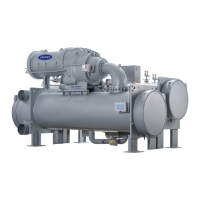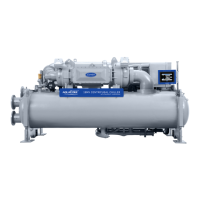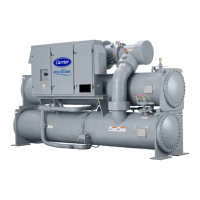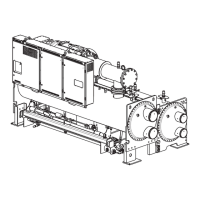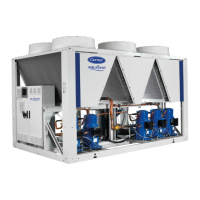78
Bit 4: Indicates that the alarm should be read and processed by
an alarm printer interface (an optional module), ServiceLink,
or a DataLINK™ device.
The RE-ALARM TIME is a time period after which, if a
preexisting and previously broadcast alarm has not been
cleared, it will be rebroadcast on the CCN network.
Other Tables — The CONSUME, NET_OPT, and RUN-
TIME screens contain parameters used with a CCN system.
See the applicable CCN manual for more information on these
screens. These tables can only be defined from a CCN
Building Supervisor.
Perform a Control Test — Check the safety controls
status by performing an automated control test. Access the
CONTROL TEST table and select a test to be performed func-
tion (see Tables 14 and 15).
The Automated Control Test checks all outputs and inputs
for function. The compressor must be in the OFF mode to
operate the controls test. The compressor can be put in OFF
mode by pressing the STOP push-button on the ICVC. Each
test asks the operator to confirm the operation is occurring and
whether or not to continue. If an error occurs, the operator can
try to address the problem as the test is being done or note the
problem and proceed to the next test.
When the control test is finished or the softkey is
pressed, the test stops, and the CONTROL TEST menu dis-
plays. If a specific automated test procedure is not completed,
access the particular control test to test the function when
ready. The CONTROL TEST menu is described in Table 15.
The EVAPORATOR PRESSURE, CONDENSER PRES-
SURE, DISCHARGE PRESSURE, and OIL PRESSURE
DELTA P pressure transducers should be calibrated prior to
start-up. If pressure transducers are installed on the waterbox
nozzles, CHILLED LIQUID DELTA P and CONDENSER
LIQUID DELTA P transducers should also be calibrated.
Table 14 — Control Tests
*P compressors with economizer option only
NOTE: During any of the tests, an out-of-range reading will have an asterisk
(*) next to the reading and a message will be displayed.
Table 15 — Control Test Menu Functions
Pressure Transducer and Optional Flow
Device Calibration —
Transducers measuring single
pressure values (such as CONDENSER PRESSURE and
EVAPORATOR PRESSURE) are calibrated individually, while
a pair of transducers measuring a pressure differential (OIL
PRESSURE DELTA P, CHILLED LIQUID DELTA P, or
CONDENSER LIQUID DELTA P) are calibrated together as a
differential. Transducers for sensing liquid side flow are not
provided as standard. Oil pressure, refrigerant pressure and
liquid delta P readings can be viewed and calibrated from the
COMPRESS and HEAT_EX screens on the ICVC controller.
Each transducer or transducer pair can be calibrated at two
points: “zero” (0 psig or 0 kPa) and “high end” (between 25
and 250 psig, or between 173 and 1724 kPa). It is good prac-
tice to calibrate at initial start-up. Calibration is particularly
important at high altitudes to ensure the proper refrigerant
temperature-pressure relationship.
ZERO POINT CALIBRATION — Shut down the compres-
sor, and cooler and condenser pumps. There must be no water
flow through the heat exchangers, but these systems must be
filled. For differential pairs, leave the transducers installed. For
CONTROL TEST
CCM
Thermistors,
PD4 EXV
Thermistor*
Check of all thermistors.
CCM Pressure
Transducers
Check of all transducers.
Pumps
Checks operation of pump outputs; pumps are activated.
Also tests associated inputs such as flow or pressure.
Discrete Outputs Activation of all on/off outputs individually.
Oil Reclaim
Output
Checks CCM 4-20mA oil reclaim output with
power removed from oil reclaim actuator.
Head Pressure
Output
Manually varies the head pressure output
from low voltage field wiring terminal strip.
Pumpdown/
Lockout
Pumpdown prevents the low refrigerant alarm during
evacuation so refrigerant can be removed form the unit.
Also locks the compressor off and starts the liquid
pumps.
Terminate
Lockout
To charge refrigerant and enable the chiller
to run after pumpdown lockout.
Condenser
Level EXV
Output (P
Compressor
Only)
Manually varies the EXV output. After test the EXV will
be driven to the fully closed position.
Economizer EXV
Output (P
Compressor
Only)
Manually varies the economizer EXV output. After test
the economizer EXV will be driven to the fully closed
position.
TESTS TO BE
PERFORMED
DEVICES TESTED
1. Thermistors
Entering Chilled Liquid
Leaving Chilled Liquid
Entering Cond Liquid
Leaving Cond Liquid
Evap Refrig Liquid Temp
Comp Discharge Temp
Oil Sump Temp
Vaporizer Temp
Comp Motor Winding Temp
Spare Temperature 1
Spare Temperature 2
Remote Reset Sensor
Economizer Superheat Sensor (P compressor
only)
2. Pressure
Transducers
Evaporator Pressure
Condenser Pressure
Discharge Pressure
Oil Pressure Delta P
Chilled Liquid Delta P
Condenser Liquid Delta P
Transducer Voltage Ref
Humidity Sensor Input
Relative Humidity
Economizer Pressure (P compressor only)
3. Pumps
Operates Pump, Displays Delta P and confirms
flow for oil pump, chilled liquid pump and
condenser liquid pump.
4. Discrete
Outputs
Oil Heater Relay
Seconday Oil Heater Relay (P Compressor Only)
Vaporizer Heater
Hot Gas Bypass Relay
Tower Fan Relay Low
Tower Fan Relay High
Alarm Relay
VFD Coolant Solenoid
Shunt Trip Relay
5. Oil Reclaim
Output
Percentage and mA (% and mA)
6. Head Pressure
Output
Head Pressure Reference (4 to 20mA)
(The output is 2 mA when the chiller is not
running.)
7. Pumpdown
Lockout
When using pumpdown/lockout, observe freeze
up precautions when removing charge:
Instructs operator which valves to close and when.
Starts chilled liquid and condenser liquid pumps
and requests flow confirmation.
Monitors:
Evaporator pressure
Condenser pressure
Evaporator temperature during
pumpout procedures
Turns pumps off after pumpdown.
Locks out compressor.
8. Terminate
Lockout
Starts pumps and monitors flows.
Instructs operator which valves to open and when.
Monitors:
Evaporator pressure
Condenser pressure
Evaporator temperature during
charging process
Terminates compressor lockout.

